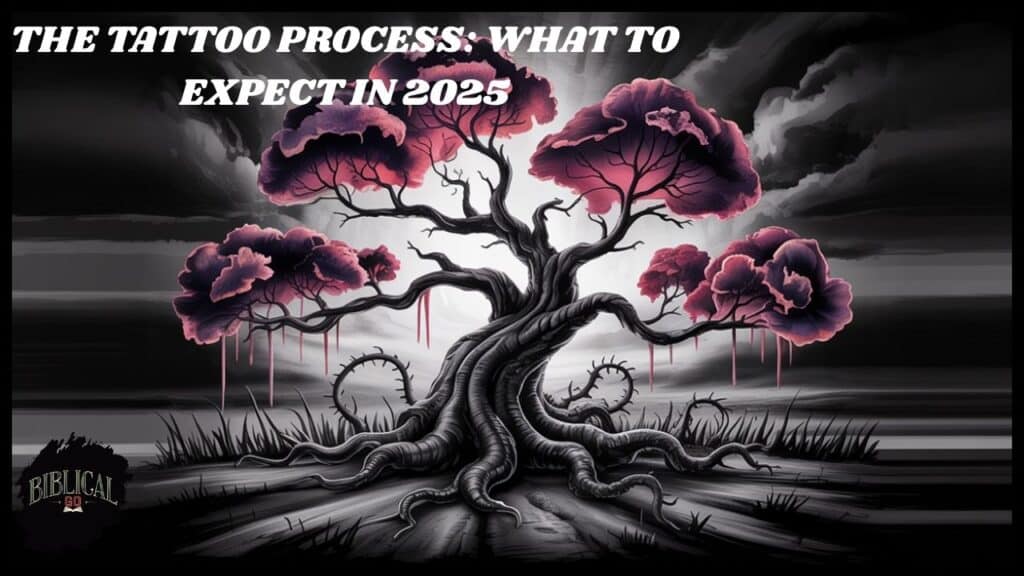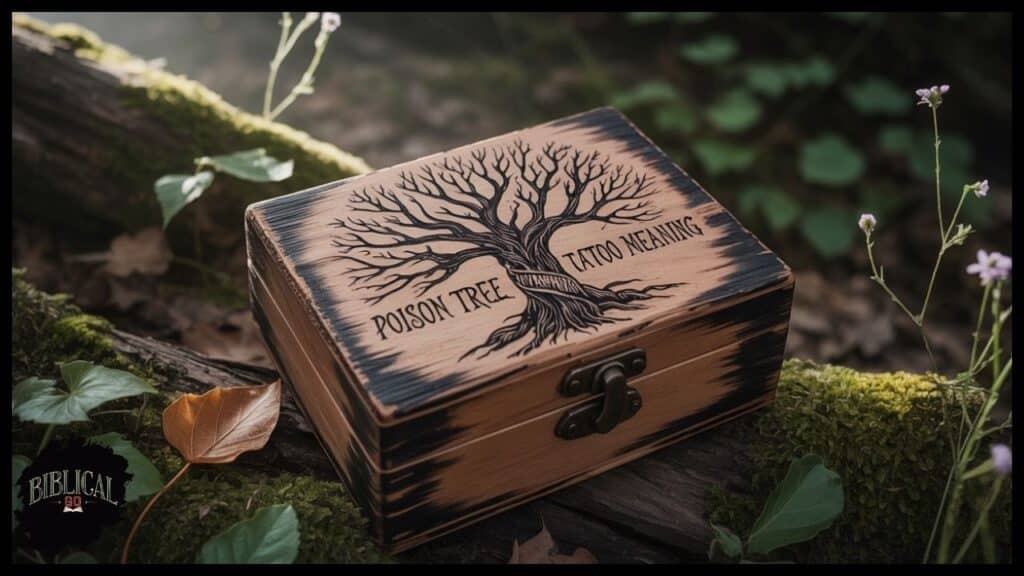Poison Tree Tattoo Meaning: The poison tree tattoo meaning has evolved into one of the most profound forms of personal expression in contemporary body art.
This powerful symbol, rooted in William Blake’s haunting poetry, represents far more than aesthetic appeal it’s a declaration of emotional awareness and personal journey through life’s darkest moments.
The Dark Roots: William Blake’s Literary Genesis
William Blake’s 1794 poem “A Poison Tree” from his collection “Songs of Experience” planted the seed for this enduring symbol. The poem’s opening lines “I was angry with my friend: I told my wrath, my wrath did end” immediately establish the central theme of emotional conflict that resonates powerfully in modern tattoo symbolism.
Blake wrote during the Romantic period, when artists challenged conventional thinking about human nature. His work explored the duality between innocence and experience, light and shadow. The poison tree tattoo embodies this philosophical tension perfectly.
The historical context matters deeply. Blake lived through the Industrial Revolution and witnessed society’s increasing complexity. His poetry addressed suppressed emotions and their destructive potential themes that feel remarkably relevant in 2025’s mental health-conscious culture.
“I was angry with my foe: I told it not, my wrath did grow.” – William Blake
This verse captures the essence of what makes poison tree tattoo meaning so compelling. It’s not just about anger it’s about the transformation that occurs when we nurture negative emotions instead of addressing them directly.
Psychological Symbolism: What Your Poison Tree Reveals
Suppressed Emotions and Their Consequences
Modern psychology validates Blake’s intuitive understanding of emotional suppression. When we bottle up anger, resentment, or betrayal, these feelings don’t disappear they grow stronger, like Blake’s metaphorical tree.
The poison tree tattoo serves as a powerful reminder of this psychological truth. Many people choose this design after experiencing:
- Betrayal by trusted friends or family
- Workplace conflicts that couldn’t be openly addressed
- Romantic relationships that ended in deception
- Family dynamics requiring emotional suppression
Tattoo symbolism experts note that the poison tree represents both the problem and the solution. By acknowledging these hidden emotions, we begin the healing process.
The Duality of Human Nature
Carl Jung’s concept of the shadow self aligns perfectly with poison tree tattoo meaning. We all possess both light and dark aspects, and the healthiest individuals acknowledge this duality rather than denying it.
The tree itself embodies this concept beautifully:
| Light Aspects | Shadow Aspects |
|---|---|
| Growth and life | Poison and death |
| Beauty of branches | Dangerous fruit |
| Natural strength | Hidden toxicity |
| Seasonal renewal | Eternal warning |
This complex storytelling through imagery makes the poison tree tattoo particularly meaningful for those who’ve learned to embrace their complete selves.
Transformation Through Adversity
Perhaps the most powerful aspect of poison tree tattoo meaning lies in its representation of growth through hardship. Like actual trees that survive harsh conditions, people who choose this tattoo often view their struggles as essential to their development.
The concept of resilience emerges strongly here. The tree doesn’t just survive it thrives, producing fruit (albeit poisonous) and maintaining its strength. This metaphorical warning reminds us that our difficult experiences shape us fundamentally.
Cultural and Spiritual Interpretations Across 2025
The poison tree tattoo has gained remarkable cultural significance beyond its literary origins. In 2025, several movements have embraced this symbol:
Mental Health Awareness: The tattoo has become a symbol for those who’ve overcome depression, anxiety, or trauma. It represents the emotional awareness necessary for healing.
Gothic and Dark Academia: These aesthetic movements celebrate the beauty in darkness, making the poison tree a perfect fit for their dark aesthetic preferences.
Generational Trauma Healing: Many people use this tattoo to represent breaking cycles of family dysfunction or inherited emotional patterns.
Eastern Philosophy Integration: Some interpret the poison tree through karma lens the fruit we harvest depends on the emotions we cultivate.
Design Variations That Tell Your Story
Hyper-Realistic Botanical Approaches
Realistic poison tree designs focus on scientific accuracy, often incorporating actual poisonous plants like:
- Oleander: Beautiful but deadly flowers
- Foxglove: Elegant purple blooms hiding cardiac toxins
- Nightshade: Dark berries with ominous reputation
- Manchineel: Known as the “death apple” tree
These designs require exceptional artistic skill and multiple sessions. The detail work in leaves, bark texture, and poisonous fruits or flowers demands precision that only experienced artists can deliver.
Abstract and Minimalist Interpretations
Minimalist poison tree designs appeal to those who prefer subtle symbolic tattoos. These might include:
- Single-line tree silhouettes on the wrist
- Geometric poison apple designs
- Watercolor bleeding effects suggesting emotional flow
- Simple branch patterns with one highlighted fruit
The beauty of minimalist approaches lies in their versatility. They work well for professional environments while maintaining deep personal expression.
Literary Homage Pieces
Blake-inspired artwork often incorporates text elements, creating powerful literary tattoo design pieces. These might feature:
- Handwritten verses from the original poem
- Victorian-era typography styling
- Illuminated manuscript elements
- Integration of Blake’s visual art style
Such designs appeal particularly to literature enthusiasts and those who appreciate artistic appreciation in their body art.
Contemporary Fusion Styles
Modern tattoo artists blend traditional poison tree tattoo meaning with contemporary techniques:
- Neo-traditional: Bold colors with classic imagery
- Blackwork: Solid black designs with intricate patterns
- Dotwork: Stippling techniques creating texture
- Watercolor: Flowing colors suggesting emotional bleeding
Strategic Placement Considerations
Visibility and Professional Impact
Tattoo placement significantly affects both aesthetic impact and practical considerations:
Easily Concealed Locations:
- Ribs: Large canvas, easily hidden
- Thigh: Spacious area for detailed work
- Upper back: Professional concealment
- Inner forearm: Coverable with sleeves
Statement Piece Locations:
- Outer forearm: Visible, conversational
- Shoulder: Partial visibility option
- Calf: Seasonal concealment possible
Body Flow and Aesthetic Harmony
The tree’s natural growth pattern works beautifully with body curves. Consider how branches might follow:
- Ribcage natural curves
- Spine vertical alignment
- Shoulder blade movement
- Forearm muscle definition
Meaningful tattoo placement often incorporates symbolic significance. Some choose locations near the heart for emotional expression, while others prefer hands to represent how we “handle” our emotions.

The Tattoo Process: What to Expect in 2025
Finding the right artist for poison tree tattoo work requires careful research. Look for artists who:
- Understand literary symbolism
- Specialize in botanical accuracy
- Have experience with dark-themed tattoo work
- Communicate well about symbolic meaning
Consultation Questions:
- How do you interpret the poem’s meaning?
- What techniques best suit my skin tone?
- How will the design age over time?
- What’s your experience with detailed botanical work?
Expect multiple sessions for complex designs. Realistic poison tree tattoos often require 3-5 sessions, while minimalist versions might complete in one sitting.
Personal Stories: Why People Choose This Symbol
Sarah, a therapist from Portland, chose her poison tree tattoo after overcoming childhood trauma: “It reminds me that acknowledging my anger was the first step toward healing. The tree represents both the poison I carried and my transformation through facing it.”
Marcus, a literature professor, selected Blake-inspired artwork for his sleeve: “The poem shaped my understanding of human nature. My tattoo honors both Blake’s genius and my own journey with suppressed emotions.”
These stories highlight the personal journey aspect that makes poison tree tattoo meaning so compelling. It’s not just about the symbol it’s about the individual story behind it.
Pairing and Complementary Tattoo Ideas
Many people build larger narratives around their poison tree tattoo:
Complementary Symbols:
- Roses (beauty and thorns)
- Serpents (temptation and wisdom)
- Ravens (mystery and intelligence)
- Keys (unlocking hidden truths)
Seasonal Additions:
- Spring blossoms (renewal)
- Autumn leaves (acceptance)
- Winter branches (endurance)
- Summer fruit (consequences)
Cost Considerations and Investment Planning
Poison tree tattoo costs vary significantly based on:
| Factor | Price Range |
|---|---|
| Small minimalist | $200-500 |
| Medium realistic | $800-1,500 |
| Large detailed piece | $2,000-5,000 |
| Full sleeve integration | $4,000-10,000 |
Geographic location affects pricing substantially. Urban areas with high-end artists command premium rates, while smaller cities offer more affordable options.
Consider this a long-term investment. Quality poison tree tattoo work maintains its beauty for decades with proper care.
Future Evolution: Where This Symbol Heads Next
The poison tree tattoo meaning continues evolving as society changes. Emerging trends include:
Technology Integration: Some artists experiment with UV-reactive inks that reveal hidden elements under blacklight.
Cultural Fusion: Asian-inspired poison tree designs blend Eastern and Western symbolism.
Environmental Consciousness: Eco-friendly ink options appeal to environmentally aware clients.
Mental Health Advocacy: The symbol increasingly represents mental health awareness and emotional healing.
Embracing Your Dark Garden
The poison tree tattoo offers a unique opportunity for personal expression that goes beyond surface aesthetics. It’s a symbol that grows more meaningful over time, reflecting your journey with emotional conflict, betrayal, and ultimately, transformation.
Whether you choose a realistic poison tree, minimalist design, or Blake-inspired artwork, remember that this tattoo represents your courage to face difficult emotions. It’s a permanent reminder that acknowledging our shadows often leads to our greatest growth.
The poison tree tattoo meaning resonates because it reflects universal human experience we all carry some poison, and we all have the power to transform it into wisdom. In 2025, this symbol continues evolving, but its core message remains constant: suppressed emotions have consequences, but awareness brings healing.
Your poison tree tattoo becomes part of your story, a visual reminder of the duality within us all and the resilience required to thrive despite life’s challenges. It’s not just body art it’s a philosophy made permanent, a commitment to emotional awareness and personal growth that will serve you throughout your journey.
Conclusion
Your poison tree tattoo isn’t just ink it’s courage made visible. This powerful symbol transforms Blake’s dark poetry into a personal declaration that you’ve faced your shadows and emerged stronger.
Every glance at your poison tree tattoo reminds you that suppressed emotions once threatened to consume you, but now they’ve become part of your strength.
It’s a badge of emotional awareness, a conversation starter about resilience, and proof that sometimes the most beautiful growth comes from life’s most toxic moments.
Frequently Asked Questions About Poison Tree Tattoo Meaning
What is the main poison tree tattoo meaning behind this popular design?
The poison tree tattoo meaning centers on acknowledging suppressed emotions and personal transformation. Based on William Blake’s poem, it represents how hidden anger and resentment grow toxic when left unaddressed, making it a powerful symbol for emotional awareness and healing.
Does poison tree tattoo meaning relate to revenge or negative emotions only?
While poison tree tattoo meaning does acknowledge dark emotions like betrayal and anger, it’s ultimately about growth and resilience. The symbol represents learning from difficult experiences and transforming negative emotions into wisdom rather than letting them poison your life.
How does William Blake’s poem influence poison tree tattoo meaning today?
Blake’s 1794 poem “A Poison Tree” directly shapes poison tree tattoo meaning by providing the foundational metaphor. The poem’s message about emotional suppression and its consequences resonates with modern mental health awareness, making this literary tattoo design increasingly meaningful.
What placement best represents poison tree tattoo meaning symbolically?
Poison tree tattoo meaning works powerfully in any placement, but many choose locations near the heart (ribs, chest) to represent emotional conflict, or on the forearm where it’s visible as a daily reminder of their personal journey and transformation.
Can poison tree tattoo meaning be expressed through minimalist designs?
Absolutely! Poison tree tattoo meaning translates beautifully into minimalist styles through simple tree silhouettes, single branches, or geometric fruit designs. The symbol’s power lies in its concept, not complexity even subtle designs carry the full weight of Blake’s profound metaphorical warning.
Read more knowledgeable blogs on Biblical Go

Piper McMillan is a devoted writer and Bible enthusiast, offering insightful guides on Bible verses. Her blog provides practical interpretations and reflections, helping readers deepen their faith and understanding of Scripture through accessible and inspiring content.



